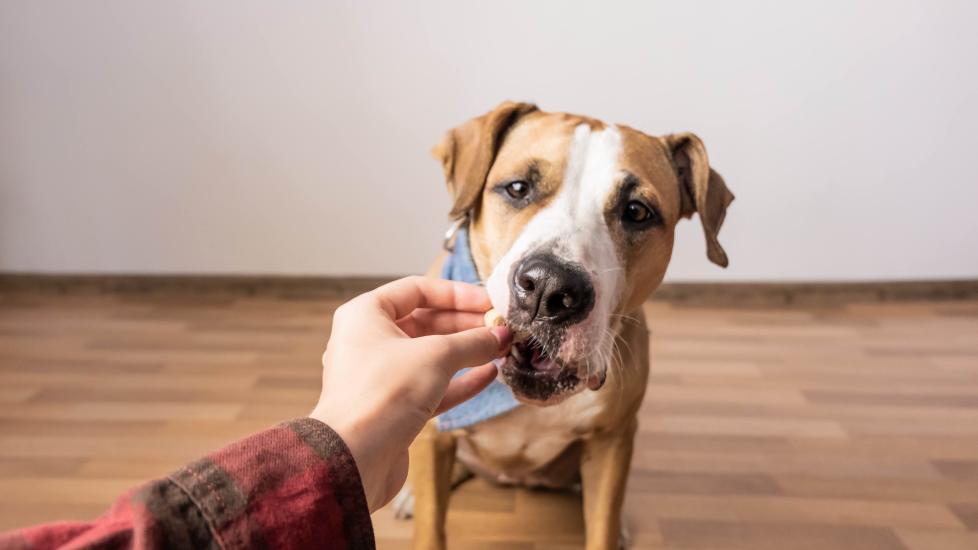5 Mistakes That Could Cause Your Dog To Gain Weight
We love our pets, and it’s understandable that we want to show our love through food. But this can lead to some unwanted pounds packing on to our pets. If some extra weight snuck up on your dog recently, some adjustments may be necessary.
Here are some common mistakes pet parents make when it comes to keeping their dogs healthy, and how you can help your pup get back to an ideal weight.
1. You're ‘Guestimating’ How Much to Feed
Measuring your pet’s food is the first step to make sure they are getting the right amount.
“When I ask pet parents how much they feed, most have no idea,” says Dr. Judy Morgan, DVM. “When I use a measuring cup and actually show them what 1 cup of food looks like, they are amazed.”
If you're using an old cup, fistful, or bowl to scoop out the food, Dr. Morgan suggests switching to a measuring cup before you make any other changes. Read the bag to find out how much you should be feeding your dog based on their ideal weight, or ask your vet if you're not sure. Then use a proper measuring cup so you can feed the correct amount every time.
Leaving food out all day can also lead to overeating. If you're gone for long periods of time during the day, consider using a portion control programmable feeder, like the Aspen Pet LeBistro® pet feeder, so your dog still has access to food—but only in the right amounts.
2. Forgetting To Count Treats as Calories
Some store-bought treats can be very high in calories, so just a few treats can cause weight gain.
“I routinely see treats, especially dog biscuits, make up more than one-third of a dog’s overall daily caloric needs,” says Dr. Justin Shmalberg, DVM. And pet parents don’t always remember to subtract those calories from how much food they’re feeding.
It’s also important to be mindful of how many extra treats your dog might be getting during training. Treats are a great way to provide your dog with positive reinforcement, but even little training treats can add up quickly.
In general, you don’t want more than 10% of a pet’s daily calories coming from treats. And those treat calories must be accounted for in your daily calorie targets, says Dr. Shmalberg.
“You can use a bigger treat so long as you break it up and you are aware of the overall number of calories in each treat, so you can keep track of what you’re feeding,” he says.
When choosing treats, Dr. Morgan says to read labels to find a treat that's low in calories.
3. Your Dog Isn’t Getting Enough Exercise
Exercise can take many forms, from walking to jogging to playing fetch or Frisbee in the backyard. Exercise is an important part of a dog’s physical and mental health. Many problems, including weight gain, can occur if a pet is not getting enough exercise.
For many pet parents, walking is the easiest and most reliable way to exercise their pup, and most dogs do well with a daily 20- to 30-minute walk.
Remember: While exercise can help keep you and your pup lean, it’s not always enough to combat extra weight your pet is already carrying. Work with your veterinarian to craft the right exercise and weight loss plan for your pet.
4. Not Feeding the Best Food for Your Dog
Finding the right food for your pet can be tricky, and it’s always recommended to consult your vet to help you choose the best dog food. However, a good rule of thumb is to look for a well-balanced, high-quality dog food approved by the Association of American Feed Control Officials (AAFCO).
You should also feed your dog according to their life stage: puppy, adult, or senior.
If your pet needs to lose a moderate or significant amount of weight, over-the-counter weight loss diets or “light” options and exercise may not be enough. In those cases, prescription diets may be needed to help your pup shed the pounds.
Prescription weight loss diets are backed by research studies and proven to help pets lose weight. Some common prescription diets to discuss with your vet include Hill’s® Metabolic, which works with your pet’s individual metabolism to help them lose weight, and Royal Canin® Satiety, which helps dogs feel fuller and participate in less begging behavior.
5. Feeding Table Scraps
Table scraps and human food are, as a general rule, high in calories and fat. In addition to causing clinical signs like vomiting and diarrhea, which can progress to gastroenteritis or pancreatitis, eating human food can contribute significantly to a dog’s weight problem.
Commercially available pet food diets are balanced for dogs and better choice to keep them happy and healthy.
By Diana Bocco
Featured Image: Photoboyko
